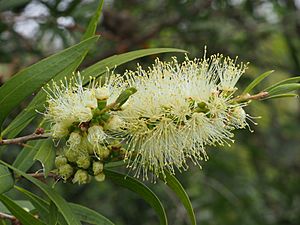Willow bottlebrush facts for kids
Quick facts for kids Willow bottlebrush |
|
|---|---|
 |
|
| M. salicina flowers in Nana Glen | |
| Scientific classification | |
| Genus: |
Melaleuca
|
| Species: |
salicina
|
| Synonyms | |
|
|
The Melaleuca salicina, often called willow bottlebrush, is a plant from the Myrtaceae family. It grows naturally only in eastern Australia. Some plant experts in Australia still use its older name, Callistemon salignus. This plant is usually a shrub or a small tree. It has soft leaves, new pink growth, and white, papery bark. In spring, it grows spikes of white or creamy flowers that look like a bottlebrush.
Contents
What the Willow Bottlebrush Looks Like
The Melaleuca salicina is a shrub or a small tree. It can grow up to 15 meters (about 49 feet) tall. It has soft, new leaves that are pink. Its bark is white or grey and feels like paper. The leaves grow one after another along the stem. They are usually 38 to 144 millimeters (about 1.5 to 5.7 inches) long and 5 to 16 millimeters (about 0.2 to 0.6 inches) wide. They are flat and narrow, getting thinner at both ends. You can see a main vein, veins along the edges, and many other clear veins on the leaves.
The flowers are white or creamy-white. They grow in spikes at the end of branches, or around them. The branches keep growing even after the flowers appear. These flower spikes are 20 to 35 millimeters (about 0.8 to 1.4 inches) wide and 50 to 80 millimeters (about 2 to 3.1 inches) long. Each spike has 10 to 40 individual flowers. The petals are small, about 2.6 to 4 millimeters (0.1 to 0.16 inches) long, and they fall off as the flower gets older. Each flower has many tiny parts called stamens, usually 48 to 65 of them. This plant flowers from September to November. After flowering, it produces small, woody fruits called capsules. These capsules are about 3.8 to 4.4 millimeters (0.15 to 0.17 inches) long and 4 to 5 millimeters (0.16 to 0.2 inches) wide.
How it Got its Name
This bottlebrush plant was first officially described in 1797 by a scientist named James Edward Smith. He first called it Metrosideros saligna. Later, in 1826, another botanist, Robert Sweet, moved it to the group of plants called Callistemon. In 2006, Lyndley Craven changed its name again to Melaleuca salicina. The part of the name salicina means it looks like a willow tree (from the Salix group) because of its leaves.
Where the Willow Bottlebrush Grows
This melaleuca plant grows in New South Wales, Australia. You can find it from the border with Victoria all along the coast and into the mountain ranges. It also grows north to the Biloela and Bundaberg areas in Queensland. It likes to grow near rivers and other waterways, and in flat areas near rivers.
Using the Willow Bottlebrush in Gardens
The Melaleuca salicina has been a popular garden plant for many years. People often knew it by its old name, Callistemon salignus. It even won an award from the Royal Horticultural Society for being a great garden plant. This plant is good for creating privacy screens or for planting along streets. It's also a nice choice for parks and home gardens. Its flowers are great for attracting birds to your yard! This plant can grow in many different types of soil. It can handle both wet and dry conditions, and even areas close to the coast. However, it doesn't like very cold, frosty weather. You can sometimes find pink and red versions of this plant in gardens too.
Images for kids
-
M. salicina growing in Coffs Harbour
-
M. salicina in woodland near Moonee Beach
-
M. salicina in Nana Glen





